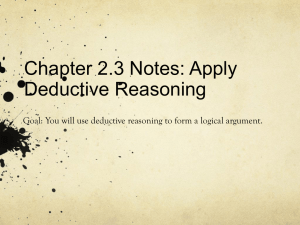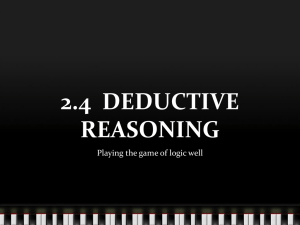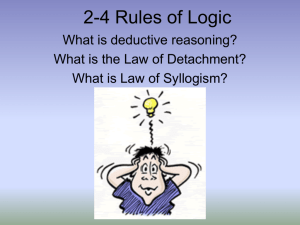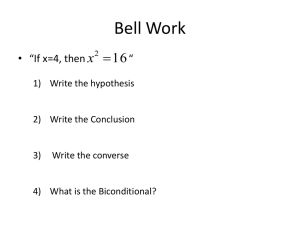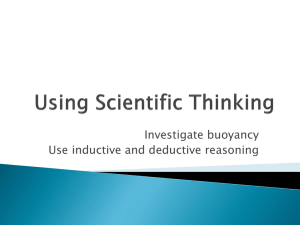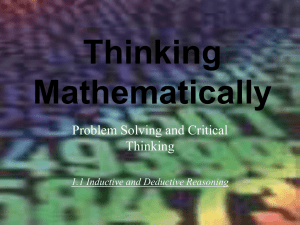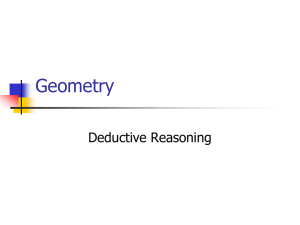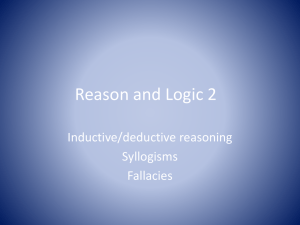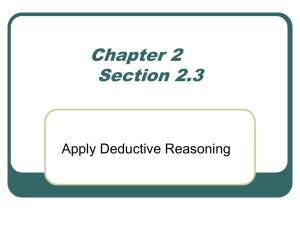File
advertisement
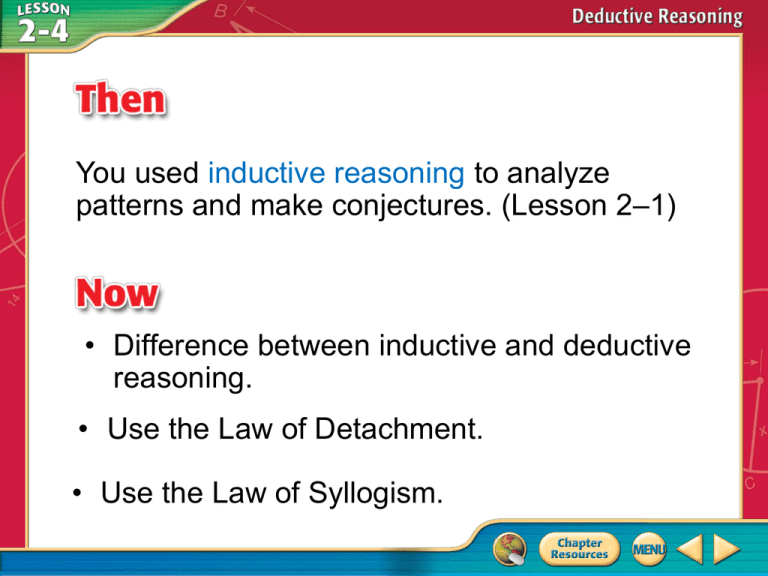
You used inductive reasoning to analyze patterns and make conjectures. (Lesson 2–1) • Difference between inductive and deductive reasoning. • Use the Law of Detachment. • Use the Law of Syllogism. • deductive reasoning • valid • Law of Detachment • Law of Syllogism Inductive and Deductive Reasoning A. WEATHER Determine whether the conclusion is based on inductive or deductive reasoning. In Miguel’s town, the month of April has had the most rain for the past 5 years. He thinks that April will have the most rain this year. Answer: Miguel’s conclusion is based on a pattern of observation, so he is using inductive reasoning. Inductive and Deductive Reasoning B. WEATHER Determine whether the conclusion is based on inductive or deductive reasoning. Sandra learned that if it is cloudy at night it will not be as cold in the morning than if there are no clouds at night. Sandra knows it will be cloudy tonight, so she believes it will not be cold tomorrow morning. Answer: Sandra is using facts that she has learned about clouds and temperature, so she is using deductive reasoning. A. Determine whether the conclusion is based on inductive or deductive reasoning. Macy’s mother orders pizza for dinner every Thursday. Today is Thursday. Macy concludes that she will have pizza for dinner tonight. A. inductive A. A B. B B. deductive 0% B A 0% B. Determine whether the conclusion is based on inductive or deductive reasoning. The library charges $0.25 per day for overdue books. Kyle returns a book that is 3 days overdue. Kyle concludes that he will be charged a $0.75 fine. A. inductive A. A B. B B. deductive 0% B A 0% Use the Law of Detachment Determine whether the conclusion is valid based on the given information. If not, write invalid. Explain your reasoning. Given: If a figure is a square, then it is a parallelogram. The figure is a parallelogram. Conclusion: The figure is a square. Step 1 Identify the hypothesis p and the conclusion q of the true conditional. p: A figure is a square. q: The figure is a parallelogram. Use the Law of Detachment Step 2 Analyze the conclusion. The given statement the figure is a parallelogram satisfies the conclusion q of the true conditional. However, knowing that a conditional statement and its conclusion are true does not make the hypothesis true. The figure could be a rectangle. Answer: The conclusion is invalid. The following is a true conditional. Determine whether the conclusion is valid based on the given information. Given: If a polygon is a convex quadrilateral, then the sum of the interior angles is 360. ABCD is a convex quadrilateral. Conclusion: The sum of the interior angles of A. A ABCD is 360. B. B C. C A. valid B. not valid 0% C 0% B C. cannot be determined A 0% Judge Conclusions Using Venn Diagrams Determine whether the conclusion is valid based on the given information. If not, write invalid. Explain your reasoning using a Venn diagram. Given: If a triangle is equilateral, then it is an acute triangle. The triangle is equilateral. Conclusion: The triangle is acute. Understand Draw a Venn diagram. According to the conditional, if a triangle is equilateral, then it is acute. Draw a circle for acute triangles. Draw a circle for equilateral triangles inside the circle for acute triangles. Judge Conclusions Using Venn Diagrams Plan We know that the given triangle is equilateral. Solve Since all equilateral triangles are acute, the conclusion is valid. Answer: From the information given, all equilateral triangles are acute, so the conclusion is valid. Check No matter where you draw a dot for an equilateral triangle, it will always be inside the circle for acute triangles. Therefore, the conclusion is valid. Determine whether the conclusion is valid based on the given information. If not, write invalid. Use a Venn diagram to help you. Given: If a figure is a square, then it has 4 right angles. A figure has 4 right angles. Conclusion: The figure is a square. 0% B 0% A A. valid B. invalid A. A B. B Determine which statement follows logically from the given statements. (1) If Jamal finishes his homework, he will go out with his friends. (2) If Jamal goes out with his friends, he will go to the movies. A If Jamal goes out with his friends, then he finishes his homework. B If Jamal finishes his homework, he will go to the movies. C If Jamal does not go to the movies, he does not go out with his friends. D There is no valid conclusion. Read the Test Item Let p, q, and r represent the parts of the given conditional statements. p: Jamal finishes his homework. q: He goes out with his friends. r: He goes to the movies. Solve the Test Item Analyze the logic of the given conditional statements using symbols. Statement (1): p → q Statement (2): q → r Both statements are considered true. By the Law of Syllogism, p → r is also true. Write the statements for p → r. If Jamal finishes his homework, then he will go to the movies. Answer: The correct choice is B. Determine which statement follows logically from the given statements. (1) If your alarm clock goes off in the morning, then you will get out of bed. (2) If you ride a bus, then you go to work. 0% B D. There is no valid conclusion. 0% A C. If you go to work, then you get of out bed. 0% A B C D 0% D B. If your alarm clock goes off, then you go to work. A. B. C. D. C A. If you ride a bus, then you get out of bed. Apply Laws of Deductive Reasoning Draw a valid conclusion from the given statements, if possible. Then state whether your conclusion was drawn using the Law of Detachment or the Law of Syllogism. If no valid conclusion can be drawn, write no conclusion and explain your reasoning. Given: If it snows more than 5 inches, school will be closed. It snows 7 inches. p: It snows more than 5 inches. q: School will be closed. Answer: Since It snows 7 inches satisfies the hypothesis, p is true. By the Law of Detachment, a valid conclusion is School is closed. Determine whether statement (3) follows from statements (1) and (2) by the Law of Detachment or the Law of Syllogism. If it does, state which law was used. If it does not, select invalid. (1) If a children’s movie is playing on Saturday, Janine will take her little sister Jill to the movie. (2) Janine always buys Jill popcorn at the movies. A. A (3) If a children’s movie is playing on Saturday, Jill will get popcorn. B. B C. C A. Law of Detachment C. invalid 0% 0% C A 0% B B. Law of Syllogism
